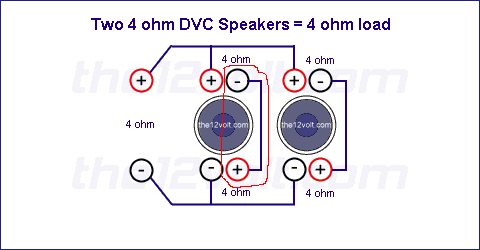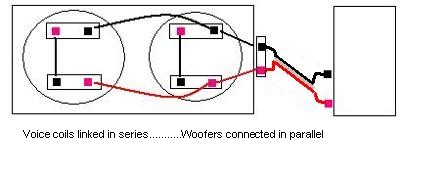If a DVC sub that has 4 ohm DVCs is rated at 300W RMS what happens to the RMS rating if it is connected in parallel bringing the impedence down to 2 ohms?? Does the RMS rating change to 150W?? if so can i drive a pair of these subs with a 2 channel amp that puts out 130W per channel @ 2 ohms?
A little help plz.
The capabilities of the subwoofer itself stay the same regardless of how the voice coils are wired, as long as both coils are used. Only in the case where one coil is used and the other is left unwired would the RMS capability drop to half. The differences in wiring is to provide various "loads" onto the amplifier, which is needed for the amp to produce current.
If you have two subs, and each sub is capable of 300 watts RMS, then you want to put the right amount of load onto the amplifier so that it provides about 600 watts to the pair. You could provide less power and be fine but you have to be very careful in your setup if you provide MORE power to the subs.
Look at wiring options https://www.the12volt.com/caraudio/woofer_configurations.asp. You see that two DVC 4 ohm subs can be wired, using all four voice coils, to either 4 ohms or 1 ohm (or not shown, 16 ohms). Look at your amp's rated output and select the impedance load that would cause the amp to produce something under but close to 600 watts. Rule to remember: the higher load (4 ohm) will be gentler on the amp and the sound will be improved over the lower (1 ohm) load.
As you have a two channel amp, the 1 ohm wiring option is NOT an option. Use the 4 ohm version. But if your amp for some reason is not bridgeable, wire each sub individually to 2 ohms (look at single sub wiring options to see this) and put a sub onto each channel.
-------------
Build the box so that it performs well in the worst case scenario and, in return, it will reward you at all times.
thanks dude that was what i was looking for.
if i use the 2ed option (wireing each sub individualy to 2 ohms) does that still mean the subs requires 300W each to run perfectly? the amp that i hav puts out 130W x 2 @ 2 ohms stereo. it is bridgeable and it puts out 300W x 1 mono output @ 4 ohms.
which of the 2 options that stevdart has given will suit this setup better?
The bridged way would be the best. Although that amp lists the outputs 130 watts X 2 @ 2 ohm and 300 watts X 1 @ 4 ohm bridged (which equates to 150 watts X 2 @ 2 ohms), the ratings should probably be closer to each other than that appears. In all actuality, a bridged load at 4 ohms is identical to the output for two channels at 2 ohms each. Goofy specs.
The reason the bridged way is best is because you may get a more emphatic bass response if both subs are receiving identical signals.
130 watts or 150 watts should be plenty to bring a sub to full life. You will know that in the future if you want to upgrade the amp you could add about +6 decibels if you give each sub 300 watts. The amp would have to be able to output 600 watts into a bridged 4 ohm load, so you know that's a big amp. You should enjoy what you have, though, and not feel as if the subs will perform better with more power. They would just be louder.
-------------
Build the box so that it performs well in the worst case scenario and, in return, it will reward you at all times.
Ok so what your saying is i connect both subs in combination series/parallel as shown in the below diagram and hook it up to the mono output of the amp.
I hav a little confusion in the diagram. in the connection tht has been circled do i hav to connect the +ive of 1 coil to the -ive of the same coil??

The polarity symbols + and - that are close together represent a voice coil. So no, that diagram does not show what you asked. By the way, use a single strand of speaker wire to make connections. Here's another way to look at the same wiring diagram:

-------------
Build the box so that it performs well in the worst case scenario and, in return, it will reward you at all times.
Ok cool thanks that diagram clears things up
i've hooked it up to the amp that way and it seems 2 be running fine. i just hope i'm not straining the amp too much. oh and i hope it dosent matter which coil is wired in series and which 1 is wired in parallel cuz i don c any difference in the 2 terminal blocks.

